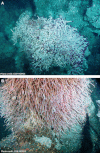Free-living bacterial communities associated with tubeworm (Ridgeia piscesae) aggregations in contrasting diffuse flow hydrothermal vent habitats at the Main Endeavour Field, Juan de Fuca Ridge
- PMID: 23401293
- PMCID: PMC3633350
- DOI: 10.1002/mbo3.70
Free-living bacterial communities associated with tubeworm (Ridgeia piscesae) aggregations in contrasting diffuse flow hydrothermal vent habitats at the Main Endeavour Field, Juan de Fuca Ridge
Abstract
We systematically studied free-living bacterial diversity within aggregations of the vestimentiferan tubeworm Ridgeia piscesae sampled from two contrasting flow regimes (High Flow and Low Flow) in the Endeavour Hydrothermal Vents Marine Protected Area (MPA) on the Juan de Fuca Ridge (Northeast Pacific). Eight samples of particulate detritus were recovered from paired tubeworm grabs from four vent sites. Most sequences (454 tag and Sanger methods) were affiliated to the Epsilonproteobacteria, and the sulfur-oxidizing genus Sulfurovum was dominant in all samples. Gammaproteobacteria were also detected, mainly in Low Flow sequence libraries, and were affiliated with known methanotrophs and decomposers. The cooccurrence of sulfur reducers from the Deltaproteobacteria and the Epsilonproteobacteria suggests internal sulfur cycling within these habitats. Other phyla detected included Bacteroidetes, Actinobacteria, Chloroflexi, Firmicutes, Planctomycetes, Verrucomicrobia, and Deinococcus-Thermus. Statistically significant relationships between sequence library composition and habitat type suggest a predictable pattern for High Flow and Low Flow environments. Most sequences significantly more represented in High Flow libraries were related to sulfur and hydrogen oxidizers, while mainly heterotrophic groups were more represented in Low Flow libraries. Differences in temperature, available energy for metabolism, and stability between High Flow and Low Flow habitats potentially explain their distinct bacterial communities.
© 2013 The Authors. Published by Blackwell Publishing Ltd.
Figures








Similar articles
-
The genome of a vestimentiferan tubeworm (Ridgeia piscesae) provides insights into its adaptation to a deep-sea environment.BMC Genomics. 2023 Feb 11;24(1):72. doi: 10.1186/s12864-023-09166-y. BMC Genomics. 2023. PMID: 36774470 Free PMC article.
-
Insights into Symbiont Population Structure among Three Vestimentiferan Tubeworm Host Species at Eastern Pacific Spreading Centers.Appl Environ Microbiol. 2016 Aug 15;82(17):5197-205. doi: 10.1128/AEM.00953-16. Print 2016 Sep 1. Appl Environ Microbiol. 2016. PMID: 27316954 Free PMC article.
-
Microbial community structure and functioning in marine sediments associated with diffuse hydrothermal venting assessed by integrated meta-omics.Environ Microbiol. 2014 Sep;16(9):2699-710. doi: 10.1111/1462-2920.12283. Epub 2013 Oct 27. Environ Microbiol. 2014. PMID: 24112684
-
Linking regional variation of epibiotic bacterial diversity and trophic ecology in a new species of Kiwaidae (Decapoda, Anomura) from East Scotia Ridge (Antarctica) hydrothermal vents.Microbiologyopen. 2015 Feb;4(1):136-50. doi: 10.1002/mbo3.227. Epub 2014 Dec 16. Microbiologyopen. 2015. PMID: 25515351 Free PMC article.
-
Microbial diversity in shallow-water hydrothermal sediments of Kueishan Island, Taiwan as revealed by pyrosequencing.J Basic Microbiol. 2015 Nov;55(11):1308-18. doi: 10.1002/jobm.201400811. Epub 2015 Jul 1. J Basic Microbiol. 2015. PMID: 26132902
Cited by
-
Ca. Endozoicomonas cretensis: A Novel Fish Pathogen Characterized by Genome Plasticity.Genome Biol Evol. 2018 Jun 1;10(6):1363-1374. doi: 10.1093/gbe/evy092. Genome Biol Evol. 2018. PMID: 29726925 Free PMC article.
-
Diversity and function of prevalent symbiotic marine bacteria in the genus Endozoicomonas.Appl Microbiol Biotechnol. 2016 Oct;100(19):8315-24. doi: 10.1007/s00253-016-7777-0. Epub 2016 Aug 24. Appl Microbiol Biotechnol. 2016. PMID: 27557714 Free PMC article. Review.
-
Emergent "core communities" of microbes, meiofauna and macrofauna at hydrothermal vents.ISME Commun. 2021 Jun 21;1(1):27. doi: 10.1038/s43705-021-00031-1. ISME Commun. 2021. PMID: 36739470 Free PMC article.
-
Draft Genome Sequence of Endozoicomonas acroporae Strain Acr-14T, Isolated from Acropora Coral.Genome Announc. 2018 Feb 8;6(6):e01576-17. doi: 10.1128/genomeA.01576-17. Genome Announc. 2018. PMID: 29439049 Free PMC article.
-
Cutting through the smoke: the diversity of microorganisms in deep-sea hydrothermal plumes.R Soc Open Sci. 2017 Apr 12;4(4):160829. doi: 10.1098/rsos.160829. eCollection 2017 Apr. R Soc Open Sci. 2017. PMID: 28484604 Free PMC article.
References
-
- Alain K, Olagnon M, Desbruyeres D, Page A, Barbier G, Juniper SK, et al. Phylogenetic characterization of the bacterial assemblage associated with mucous secretions of the hydrothermal vent polychaete Paralvinella palmiformis. FEMS Microbiol. Ecol. 2002;42:463–476. - PubMed
-
- Alain K, Zbinden M, Lesongeur N, Le Bris F, Querellou J, Gaill F, et al. Early steps in microbial colonization processes at deep-sea hydrothermal vents. Environ. Microbiol. 2004;6:227–241. - PubMed
-
- Baross JA, Deming JW. Growth of black smoker bacteria at temperatures of at least 250-degrees-C. Nature. 1983;303:423–426.
Publication types
MeSH terms
Substances
LinkOut - more resources
Full Text Sources
Other Literature Sources

